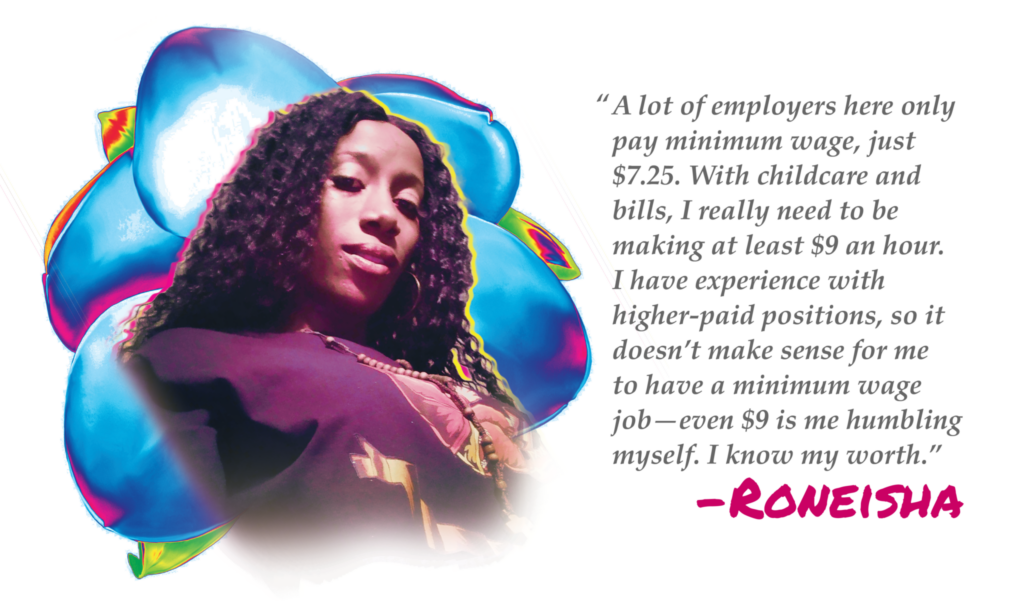Targeted policies that empower marginalized communities can lift the entire U.S. economy.

Update Thursday, April 21, at 1:08 p.m. PT: Listen to the two-minute audio version of this story. (Broadcast version by Emily Scott for Nebraska News Connection, reporting for the Ms. magazine-Public News Service collaboration.)
As many Americans begin to recover physically, socially and financially from the COVID-19 pandemic, it’s essential to pay attention to who isn’t on the mend. Time and time again, Black women are the last to recover from economic recessions, due to a combination of institutional racism and sexism, and policies that focus on the “average” American (primarily white, middle-class men), instead of taking into account the unique challenges marginalized communities face.
In 2021, the expanded child tax credit (CTC) helped alleviate some of the worst effects of the pandemic on marginalized communities. In order to focus on low-income families, the CTC provided parents $3,000 to $3,600 per child during 2021, split up into six monthly payments and a larger lump sum during tax season this year. For many low-income families, those payments were life-changing. Over the six months of monthly payments, child poverty decreased by an estimated 40 percent, lifting more than four million children out of poverty.
One low-income Black mom, Sequaya, wrote in Ms. how the CTC has impacted her daughter’s life:
“The new child tax credit payments have helped me a lot, especially since I’ve just gone from getting paid every week to having zero income. It’s helped to put shoes on my daughter’s feet and food in the fridge until my SNAP benefits come through. It’s a big relief to wake up and just know, ‘Okay, I’m not going to have to borrow money today because I have that extra help coming in.”
But after the monthly payments ended in January, low-income Black and Latino families were once again hit the hardest by economic challenges. The childhood poverty rate rose from 12 percent in December to 17 percent in January—and soared to over 23 percent for Latino children and 25 percent for Black children. Guaranteed income recipient Kimberly shared:
“I carry a really heavy load as a single mom. There’s no one else—everything is on me. So it helped ease my burden a lot when I started getting the monthly child tax credits last year. Not getting the payments anymore has definitely put a strain on my budget; there are just some things I can’t afford without that extra support coming in.”
Black families have been hit the hardest in the latest economic crisis, and Black women are more likely to face higher unemployment rates, disproportionate amounts of childcare and domestic work and other economic inequities that were exacerbated by the pandemic. For example, Johnnie had to leave her job during the pandemic to care for her daughter—just one of many unique challenges low-income working moms faced:
“During the pandemic, it was really hard for me because it was mandatory for me to go to work, but then my daughter was home from school and I didn’t have anyone to be there to help her. I ended up leaving my job because it was not safe and my daughter was not able to continue with school without my help. I didn’t have any options, so I had to quit my job to help my baby. I want her to have an education and I couldn’t let her fall behind. If I would’ve had some assistance from my employer, I also wouldn’t have been behind on my rent. I really think the government needs to have some kind of program to make sure that essential workers are taken care of.”

So, what happens if we intentionally invest in Black women? Janelle Jones, former chief economist of the Department of Labor, tackles this question in her Black Women Best framework, created in 2020 to address the pattern of Black women being left behind by economic recoveries after recessions. When policymakers put Black women first, and prioritize their needs, everyone benefits, according to Jones. Instead of “race- and gender-blind” policies, she advocates for targeted policies that empower marginalized communities and lift up the entire U.S. economy.
The Black Women Best framework has officially entered mainstream political awareness. And it’s a particularly salient time to talk economic solutions: In a recent Associated Press poll, over two-thirds of voters said the economy was their top concern ahead of the November midterm elections.
Most recently, the Congressional Caucus on Black Women and Girls released a comprehensive strategy report that centers Black women in policymaking. In the report, Rep. Bonnie Watson Coleman (D-N.J.), along with the rest of her caucus and a Black Women Best Working Group (including Magnolia Mother’s Trust‘s Aisha Nyandoro) laid out a framework for prioritizing the economic success of Black women in order to create a more equitable economy for everyone. They call for specific policies that will create economic opportunities for marginalized communities, like expanding the CTC and the income tax credit, funding community-based maternal health organizations and instituting a federal guaranteed income.
Guaranteed income, an essential strategy for centering Black women and their families, involves consistent payments directed to specific groups (like Black women living in poverty) to address economic inequities. By offering the flexibility and efficiency that come with unrestricted cash, guaranteed income can help create an economy that works for everyone, including Black women.
The Magnolia Mother’s Trust (MMT) is a real-world example of how focusing on supporting Black women can have incredible impacts on entire communities. Based in Jackson, Miss., MMT provides Black mothers living in extreme poverty $1,000 per month for a year. Even just a year of receiving consistent payments enabled the recipients to escape cycles of debt and poverty and prioritize the long-term needs of their children.
During the year-long program, the number of mothers who had health insurance coverage increased 25 percent, and the number of mothers who had life insurance coverage increased from 50 percent to 87 percent. Eighty-eight percent of moms were able to save money for emergencies, compared to 40 percent at the beginning of the year, and were 27 percent more likely to seek needed medical care than other moms not receiving guaranteed income. And MMT mothers were 20 percent more likely to have children performing at or above grade level than other mothers.
Thanks to the monthly payments, MMT moms were able to invest themselves to increase income and opportunities moving forward, setting their families up for future success. Annette, Sabrina and Danel went back to school; Tia moved out of affordable housing; and Ebony started her own nail salon. Chephirah was able to set up a college fund for her daughter, who will be the first person in her family to graduate high school.
For mom of three Roneisha, guaranteed income made her search for a job with a livable wage possible:
“I’ve worked jobs that are $11 or $12 an hour so it doesn’t make sense for me to then have a minimum wage job when I have the experience of higher-paid positions—even $9 is me humbling myself. I know my worth. The struggle with the job hunt makes the child tax credit payments and the guaranteed income even more important this year as I work to find a job that pays an even semi-livable wage.
“Before I got that call that I was selected to be part of the program, I was really struggling to keep on top of my bills and responsibilities. And now that I’m on this fixed income, it’s helped me get really good at managing my money and making sure I’m staying on top of everything and using this opportunity wisely. I’m hopeful that I can only go up from here.”

Because guaranteed income involves consistent payments and unrestricted cash, it avoids the paternalistic approach of existing welfare policies that require recipients to use money in specific ways, with lots of confusing bureaucracy and hoops to jump through. And when programs are targeted to low-income Black women, like the Magnolia Mother’s Trust, it’s not just an economic justice policy, but also a gender justice and racial justice one. Guaranteed income uplifts the most disenfranchised Americans, reducing systemic disadvantages they face thanks to an economic system created by and for white men. By putting ‘Black Women Best’ and centering their lived experiences and unique concerns, a federal guaranteed income policy would be transformational for all Americans in poverty—particularly those who face systemic barriers to financial success.
True economic recovery puts cash directly into the hands of people who need it most, empowering marginalized communities and helping struggling families. Only by focusing on the historically least prioritized people—low-income Black women—can the U.S. move towards an economic system that values and assists marginalized communities, instead of leaving them behind after recessions.
Up next:





